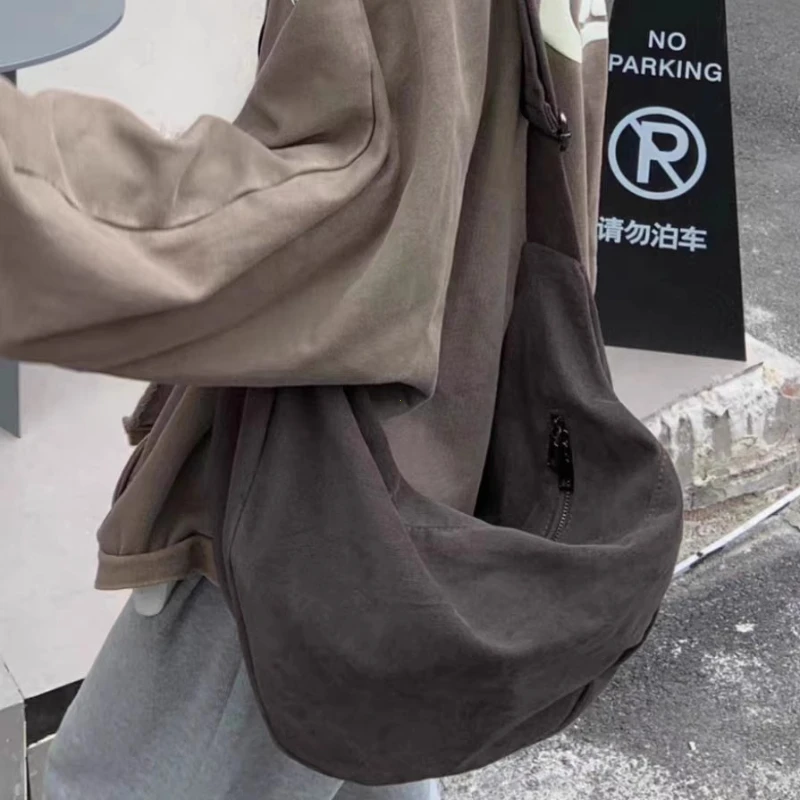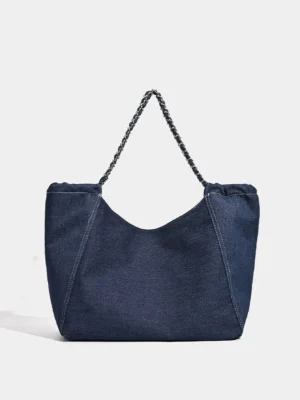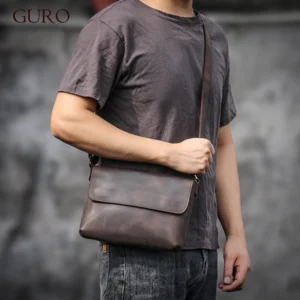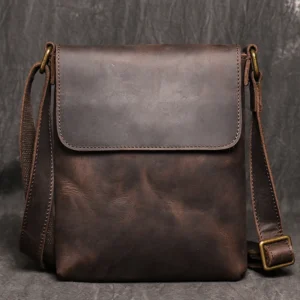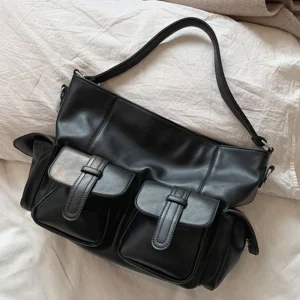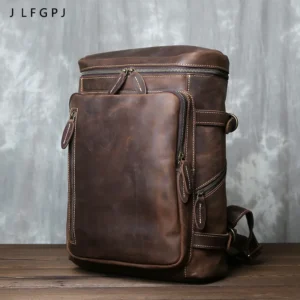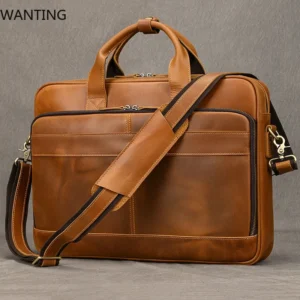The Timeless Appeal of Leather Messenger Bags
Leather messenger bags have journeyed through time from purely practical origins to becoming one of today’s most coveted fashion accessories. Originally designed for postal workers and couriers who needed hands-free ways to carry important documents, these bags were valued for their functionality first. Military applications followed, with soldiers using similar designs to carry maps and communications in the field.
What’s fascinating is how the core design has remained largely unchanged while evolving to meet modern needs. The crossbody strap, the flap closure, and the spacious interior have all stood the test of time. Today’s leather messenger bags maintain these practical elements while incorporating sophisticated touches that make them suitable for boardrooms and coffee shops alike.
The enduring popularity of leather messenger bags stems from their perfect balance of form and function. Unlike backpacks (which can appear too casual) or briefcases (often too formal), messenger bags occupy that sweet spot of professional sophistication with practical usability. They offer hands-free convenience with enough space for modern essentials—laptops, tablets, notebooks, and more—all while conveying a sense of understated style.
Fashion icons and industry leaders have incorporated these versatile bags into their signature looks, demonstrating how they complement rather than compete with thoughtfully assembled outfits. The leather messenger bag has become particularly emblematic of the modern professional who moves fluidly between different environments throughout the day.
In this guide, we’ll explore how to style your leather messenger bag across different settings, from casual weekends to formal business meetings. You’ll discover how to select the perfect bag for your needs and how to coordinate it with your wardrobe to create polished, cohesive looks for any occasion.
Finding Your Perfect Leather Messenger Bag
Understanding Leather Quality and Its Style Impact
The quality of leather used in your messenger bag dramatically influences both its appearance and how it complements your outfits. Like a fine wine, premium leather improves with age, developing character and patina that make your bag increasingly unique.
Different leather types create distinctly different impressions:
Full-grain leather: The highest quality option, featuring natural surface texture and markings. Full-grain messenger bags age beautifully, developing a rich patina that tells the story of your journey together. These bags command respect in professional settings and add authentic character to casual outfits.
Top-grain leather: Slightly more uniform in appearance than full-grain, with minor imperfections sanded away. Still durable and high-quality, these bags offer a more consistent, polished look appropriate for structured business environments.
Genuine leather: Despite the name, this is a lower grade made from leftover hide layers. While more affordable, these bags generally won’t develop the same rich character over time and might not complement premium attire as effectively.
Leather finish also plays a crucial styling role:
- Smooth leather projects sophistication and pairs well with formal attire
- Pebbled leather offers visual texture and greater durability
- Distressed leather (often called “crazy horse”) provides a vintage, casual appeal perfect for creative environments and weekend wear
The beauty of quality leather lies in how it ages. While a new bag looks pristine and formal, a well-worn messenger bag with beautiful patina tells a story and can actually elevate casual outfits with its authentic character. Consider this evolution when choosing your leather type—some professionals specifically seek bags that will develop distinctive patina, while others prefer leather that maintains a more consistent appearance over time.
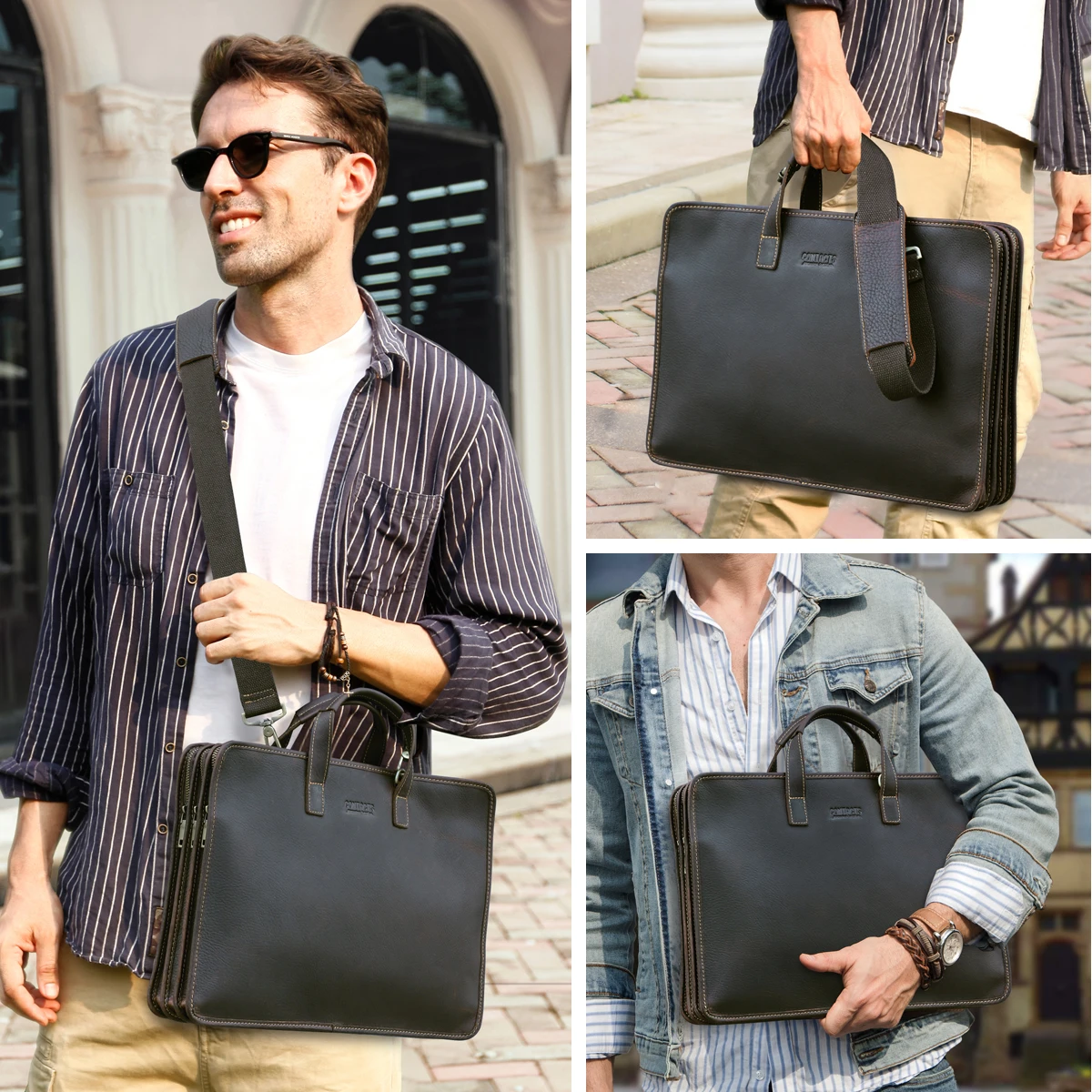
Color Selection: Beyond Basic Black and Brown
While black and brown dominate the leather bag landscape, each shade presents distinct styling possibilities and practical considerations.
Classic black leather projects authority and formality, making black leather messenger bags ideal for conservative business environments. Black seamlessly integrates with formal attire and most business wardrobes built around gray, navy, or black suits. It maintains a consistent appearance over time with less visible patina development.
Brown leather offers remarkable versatility and warmth. From rich chocolate to lighter tan tones, brown leather messenger bags complement earth tones, blues, and most casual wear. Brown leather typically develops more noticeable and attractive patina, gaining character over time.
Beyond these standards, consider:
- Tan and cognac shades for versatile styling that works brilliantly with denim, navy, and earth-toned clothing
- Oxblood and burgundy for a distinctive look that remains professional while making a subtle statement
- Navy or green leather for creative professionals seeking something unique yet versatile
Seasonal considerations also influence color choice. Lighter browns and tans naturally complement spring and summer wardrobes, while deeper browns and black align with fall and winter attire. That said, comparing tan and black leather styles reveals that both can work year-round when styled appropriately.
When deciding between contrasting or complementary colors, consider your typical wardrobe. A bag that contrasts with your usual attire becomes a statement piece, while one that complements your common color palette will integrate seamlessly across more outfits.
Size and Proportions: Finding Your Perfect Match
The right messenger bag size balances your body proportions, professional needs, and style preferences. An oversized bag on a smaller frame can appear cumbersome, while a compact bag might look insufficient on a larger build.
As a general rule, your messenger bag should be proportionate to your torso length and frame. When styling your messenger bag, position it so the bottom doesn’t extend below your hip bone for the most flattering silhouette.
Size considerations include:
Compact bags (11-13 inches wide): Ideal for essentials only—phone, wallet, tablet, and small notebooks. Best for slim builds, casual use, or minimalist professionals.
Medium bags (14-15 inches): The most versatile size, accommodating small laptops and daily necessities. Suits most body types and works across casual to business casual environments.
Large bags (16+ inches): Provides maximum capacity for larger laptops and additional items. Best suited for taller individuals or those who regularly carry numerous items.
Remember that larger bags naturally skew casual, while more compact designs can more easily transition to formal settings. The bag’s depth also affects its appearance—slimmer profiles project greater sophistication, while deeper bags suggest practicality over formality.
Design Elements: Hardware, Straps, and Pockets
The finer details of your messenger bag dramatically influence its styling versatility. Hardware finish—brass, silver-tone, or matte black—should ideally complement your typical jewelry, watch, or belt buckle for a cohesive look. Brass hardware adds warmth and pairs beautifully with brown leather, while silver-tone hardware offers contemporary appeal and complements black leather exceptionally well.
Strap design affects both functionality and aesthetics:
- Adjustable straps with substantial padding provide comfort for heavier loads
- Slimmer, unpadded straps offer a sleeker profile better suited to lighter carrying needs
- Removable straps add versatility, allowing briefcase-style carrying for formal meetings
Closure mechanisms send subtle style messages. Traditional buckles project heritage and craftsmanship but require more effort to access contents. Magnetic closures offer convenience with a cleaner look, while zippers provide security at the expense of vintage appeal.
Professional laptop messenger bags typically feature padded compartments that add bulk but protect valuable electronics. Consider how visible organizational features like external pockets affect the bag’s formality—generally, fewer visible pockets translate to greater sophistication.
The perfect messenger bag balances these elements according to your priorities. Those frequently transitioning between casual and formal environments might prioritize clean lines and minimal external details, while those valuing organization might accept the more casual appearance that comes with additional external features.
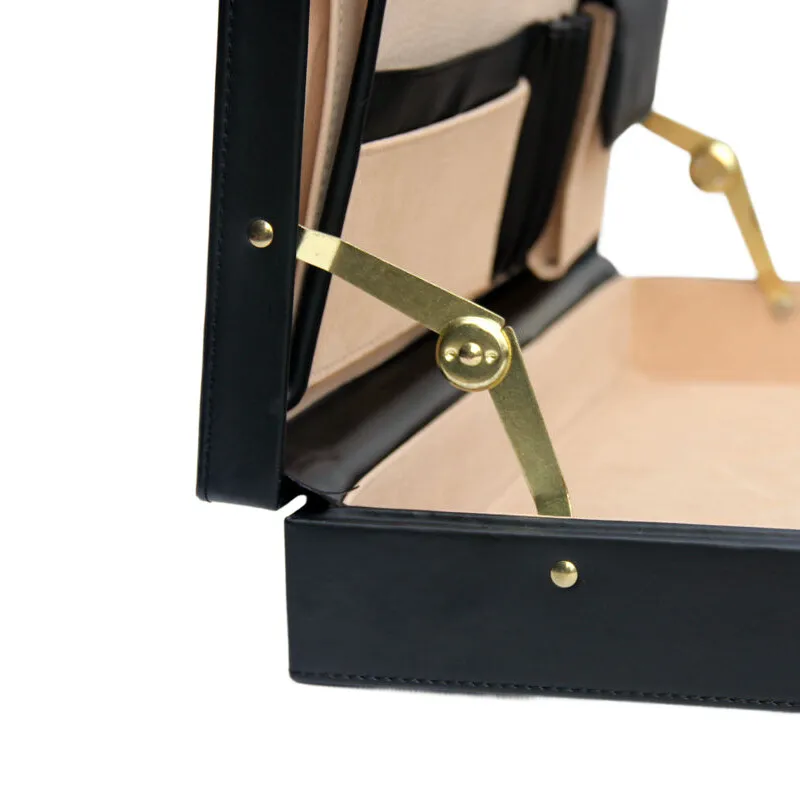
How to Wear Your Leather Messenger Bag
Positioning and Strap Adjustment
The way you position your messenger bag significantly impacts both comfort and style. Properly wearing a leather messenger bag starts with correct strap adjustment.
For crossbody wear, adjust the strap so the bag rests at or slightly above your hip bone. This position balances comfort with accessibility while creating the most flattering silhouette. The bag should lie flat against your body rather than swinging freely, which creates a more polished appearance and prevents the bag from hitting objects as you move.
For taller individuals (over 6 feet), consider positioning the bag slightly higher to maintain proportion. Those with shorter frames (under 5‘6”) may find a slightly higher position prevents the bag from hitting against the leg while walking.
The strap should cross your body diagonally from shoulder to opposite hip. Ensure it doesn’t cut across your neck uncomfortably or slip off your shoulder. Many quality bags feature padding at the shoulder section of the strap—position this padding directly on your shoulder for maximum comfort during extended wear.
To prevent clothing from bunching, adjust your garments after placing the bag. A simple smoothing of your shirt, jacket, or sweater after positioning the bag creates a cleaner appearance. With suits or structured jackets, consider wearing the bag beneath the jacket when possible for the most refined look.
Three Distinctive Carrying Methods
Each messenger bag carrying style creates a different impression and suits different situations. Mastering all three methods maximizes your bag’s versatility.
1. Crossbody Carry
The classic and most practical approach, crossbody carrying distributes weight evenly and keeps your hands free. This method works across most casual and business casual settings.
Pros: Maximum security, balanced weight distribution, hands-free convenience
Cons: Can wrinkle structured clothing, less formal appearance
Best for: Commuting, travel, casual settings, extended carrying periods
2. Over-the-Shoulder Carry
Draping the bag over one shoulder creates a more relaxed, effortless appearance. This carry method offers quick access to contents and easy removal.
Pros: Quick access to contents, easily removable, less interference with clothing
Cons: Less secure, uneven weight distribution, may slip off
Best for: Short distances, casual settings, situations requiring frequent access
3. Hand Carry (By Handle)
Many quality messenger bags include a top handle that allows briefcase-style carrying. This method projects the greatest formality and professionalism.
Pros: Most professional appearance, prevents clothing wrinkles, controlled movement
Cons: Occupies one hand, becomes tiring for heavier loads or longer periods
Best for: Professional meetings, formal settings, short carrying distances
The versatility of gender-neutral leather bag styles allows easy transition between these carrying methods as your situation changes throughout the day. This adaptability represents one of the messenger bag’s greatest advantages.
Styling Your Leather Messenger Bag for Different Occasions
Casual Weekend Outfits
Weekends call for messenger bag styling that balances relaxed comfort with thoughtful coordination. The right bag elevates even the simplest casual outfits, adding structure and purpose to relaxed ensembles.
For an effortless weekend look, pair a slightly distressed brown leather messenger with:
* Dark wash jeans or chinos
* Plain white or heathered t-shirt
* Light layering piece (unstructured blazer, denim jacket, or casual overshirt)
* Clean white sneakers or casual leather boots
This combination works because the messenger bag adds just enough polish to prevent the outfit from looking overly casual. The bag’s structured form creates appealing contrast against more relaxed clothing elements.
For casual coffee meetings or weekend errands, try:
* Medium-wash jeans
* Casual button-down with sleeves rolled up
* Lightweight quarter-zip pullover or cardigan
* Desert boots or loafers
* Vintage-style leather messenger bag
Vintage style messenger bags with subtle distressing particularly shine in casual contexts, where their lived-in character enhances rather than detracts from the overall look. The patina and character of a well-worn leather bag add authenticity to weekend wear.
When layering for cooler weather, ensure your messenger bag can be worn over lighter layers but beneath your outerwear when possible. This creates a cleaner silhouette and keeps the bag accessible without removing your coat. If wearing your bag over a jacket, choose outerwear with minimal bulk to prevent an oversized appearance.
The casual fashion style guide for messenger bags demonstrates that weekend bag styling should emphasize comfort and accessibility while maintaining a put-together appearance. Even in casual settings, thoughtful coordination between your bag and footwear creates a subtly cohesive impression.
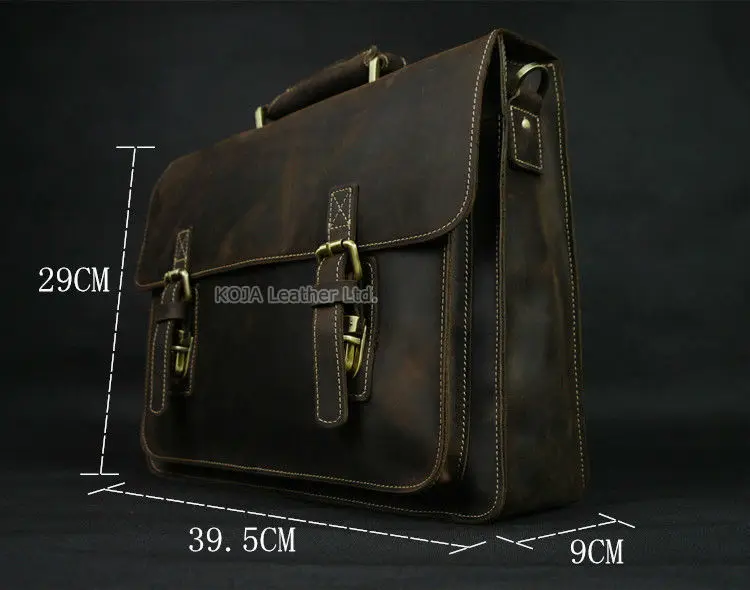
Smart Casual and Business Casual Ensembles
The business casual dress code presents the perfect opportunity for leather messenger bags to shine. This middle ground between formal and casual attire allows for personal expression while maintaining professionalism, and a well-chosen messenger bag serves as both a functional carrier and a style anchor.
For a polished business casual look appropriate for most office environments:
* Navy or gray chinos
* Light blue or white oxford shirt
* Navy blazer or unstructured sport coat
* Brown leather loafers or chelsea boots
* Brown leather messenger bag (positioned crossbody beneath the blazer or hand-carried)
This ensemble works because the messenger bag’s leather complements the leather footwear while the bag’s structure echoes the tailored elements of the outfit. For the most cohesive appearance, choose a bag shade within the same color family as your shoes and belt.
For creative professional environments that favor smart casual attire:
* Dark jeans or wool trousers
* Casual button-down or fine-gauge sweater
* Unstructured blazer or cardigan
* Brogues or clean leather sneakers
* Messenger bag with unique character or subtle distinctive details
Creative workplaces allow for greater personal expression, making this an ideal setting for bags with unique patinas or distinctive hardware. The urban style leather messenger aesthetic works particularly well in these environments, where personal style is often valued as highly as professional credentials.
When building leather messenger bag outfits, remember that the bag ideally should not be the loudest element in your ensemble. Instead, it should complement and elevate the overall look. In business casual settings, choose a messenger bag that appears intentional rather than merely functional—quality leather, thoughtful design details, and appropriate proportions signal attention to detail that extends to your professional work.
Professional and Formal Attire
Pairing a messenger bag with formal business attire requires careful consideration. While briefcases traditionally dominate formal business settings, the right messenger bag can work beautifully with suits when chosen and carried thoughtfully.
For professional environments, select a messenger bag with:
* Clean, minimal design with few external pockets
* Premium full-grain or top-grain leather with a subtle finish
* Structured shape that maintains its form even when empty
* Hardware that coordinates with your watch and other metal accents
* Conservative color (black, dark brown, or burgundy)
When wearing a messenger bag with a suit:
* Opt for hand-carry using the top handle for the most formal appearance
* If wearing crossbody, ensure the bag sits high enough not to disrupt the suit jacket’s drape
* Match the leather color with your shoes and belt for traditional business environments
* Consider the bag’s size—compact to medium styles present a more refined appearance
For formal client meetings or presentations, consider:
* Charcoal or navy suit
* Crisp white or light blue dress shirt
* Coordinated tie and pocket square
* Cap-toe oxfords or whole-cut leather shoes
* Slim professional leather messenger in matching leather tone
The key to elegantly dressing with a leather crossbody in professional settings lies in choosing understatement over flash. The bag should appear as thoughtfully selected as your suit itself, with quality construction that complements rather than competes with your formal attire.
For the most polished presentation, ensure your bag is impeccably maintained—scratches, scuffs, or excess wear can undermine an otherwise professional appearance. This attention to detail signals the same meticulous care you bring to your professional responsibilities.
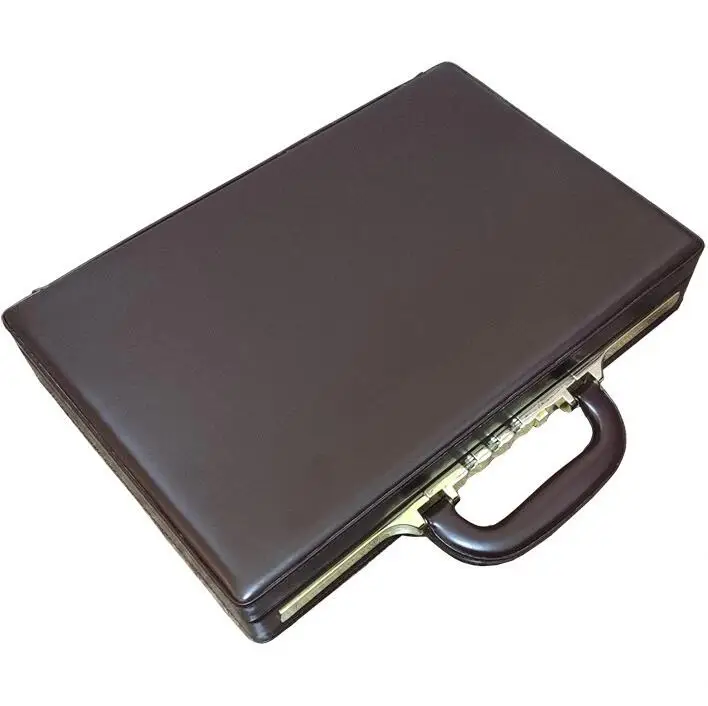
Seasonal Styling Adaptations
Adapting your messenger bag styling across seasons ensures year-round versatility while maintaining appropriate seasonal aesthetics.
Spring/Summer Approach:
* Lighter leather colors (tan, cognac, light brown) complement seasonal palettes
* Canvas and leather combination bags offer lighter weight and casual warm-weather appeal
* Pair with lighter fabrics like linen, cotton, and lightweight wool
* Consider slightly smaller bags for summer, when you’re likely carrying fewer items
* Position the bag to prevent direct contact with lightweight fabrics that may show sweat marks
Fall/Winter Approach:
* Deeper, richer leather tones (chocolate brown, burgundy, black) coordinate with heavier fabrics
* Full-leather options generally look more appropriate with fall/winter textures
* Coordinate with seasonal outerwear—ensure your bag works both over and under coats
* Consider slightly larger bags to accommodate seasonal items like gloves or light scarves
* Weather protection becomes more important—choose water-resistant options or use protectant sprays
Seasonal color coordination makes a significant difference in how integrated your bag appears with your overall look. The warm tones of brown leather naturally complement typical fall colors like burgundy, olive, and mustard, while black leather creates striking contrast against winter whites and grays.
For rainy seasons, position your bag beneath water-resistant outerwear when possible, or opt for waxed canvas and leather combinations that offer natural weather resistance. Always allow damp leather to dry naturally away from direct heat sources to prevent damage that affects both function and appearance.
Advanced Styling Techniques
Creating a Signature Look With Your Messenger Bag
Developing a signature look with your messenger bag transforms it from a mere accessory to a defining element of your personal style. This approach centers on consistency and intentional details that make the bag distinctively yours.
Consider these approaches to creating a signature messenger bag style:
- Adopt a consistent carrying method that becomes associated with your personal brand
- Select a distinctive yet versatile bag color that deviates slightly from standard options (burgundy instead of brown, navy instead of black)
- Incorporate subtle personalization that doesn’t compromise professionalism (a distinctive leather tassel, tasteful monogramming, or a unique strap adjustment)
- Establish a signature positioning—perhaps always worn crossbody with specific strap length adjustment
The key to styling a leather messenger bag as a signature piece lies in consistency combined with thoughtful differentiation. Your chosen style should be recognizable without being costume-like, distinctive without being unprofessional.
For professional environments with dress codes, focus on subtle differentiation through quality and craftsmanship rather than flashy customization. The rich patina that develops on quality leather over time creates natural personalization that speaks to your journey and experience.
Everyday use messenger bags become extensions of your professional identity when you maintain consistency in how they’re styled and carried. This consistency builds association between you and your signature accessory, strengthening your professional image every time you enter a room.
The Art of Color Coordination and Contrast
Moving beyond basic matching, sophisticated color coordination creates visual harmony between your messenger bag and outfit. This elevates your entire appearance from merely appropriate to exceptionally well-styled.
Consider these advanced color approaches:
Tonal Coordination:
Rather than exact matching, select bag leather that falls within the same color family as your shoes and belt but allows slight variation in shade. This creates sophisticated cohesion while avoiding the rigidity of perfect matching.
Complementary Contrast:
Place your bag color opposite your main outfit color on the color wheel for striking yet harmonious contrast. A navy blue suit paired with a cognac leather messenger creates this effective complementary relationship.
Strategic Pop:
In monochromatic or neutral outfits, your messenger bag can serve as the controlled color accent. A burgundy leather messenger against a gray suit adds visual interest without overwhelming the professional appearance.
Seasonal Color Theory:
Align your bag with seasonal color theory—warmer leather tones for fall/winter, cooler or lighter tones for spring/summer. This subtle alignment creates subconscious seasonal appropriateness.
When mastering streetwear with messenger bags, the rules become more flexible, allowing for greater contrast and more distinctive color pairings. The underlying principle remains: color relationships should appear intentional rather than accidental.
For those new to advanced color coordination, start with neutrals (black, brown, navy, gray) before experimenting with more distinctive color combinations. Even within these neutrals, thoughtful pairing—such as black leather with charcoal rather than navy—creates subtle sophistication.
Playing with Texture Combinations
Texture interplay between your messenger bag and clothing creates visual interest and sophistication even within monochromatic or simple color palettes. Understanding texture relationships allows you to create depth and dimension in your styling.
Effective texture combinations include:
- Smooth leather messenger bags against textured clothing (tweed jackets, cable-knit sweaters)
- Pebbled or textured leather satchels paired with smoother fabrics (fine wool suits, silk blends)
- Waxed canvas and leather combinations that complement denim and rugged fabrics
- Distressed leather that softens the formality of business attire for creative environments
Seasonal texture considerations significantly impact overall coherence:
* Fall/Winter: Pair more substantial, richly textured leathers with heavier fabrics like wool, tweed, and flannel
* Spring/Summer: Lighter-textured leathers or canvas combinations complement linen, lightweight cotton, and tropical wools
The contrast between your bag’s texture and your clothing creates visual tension that draws interest. A highly structured leather bag against the soft drape of a cashmere sweater creates appealing juxtaposition that elevates both elements.
This texture strategy extends to coordinating your bag with other leather accessories. Rather than matching textures exactly, slight variation—such as smooth leather shoes with subtly pebbled leather bag—creates more sophisticated harmony than perfect matching.
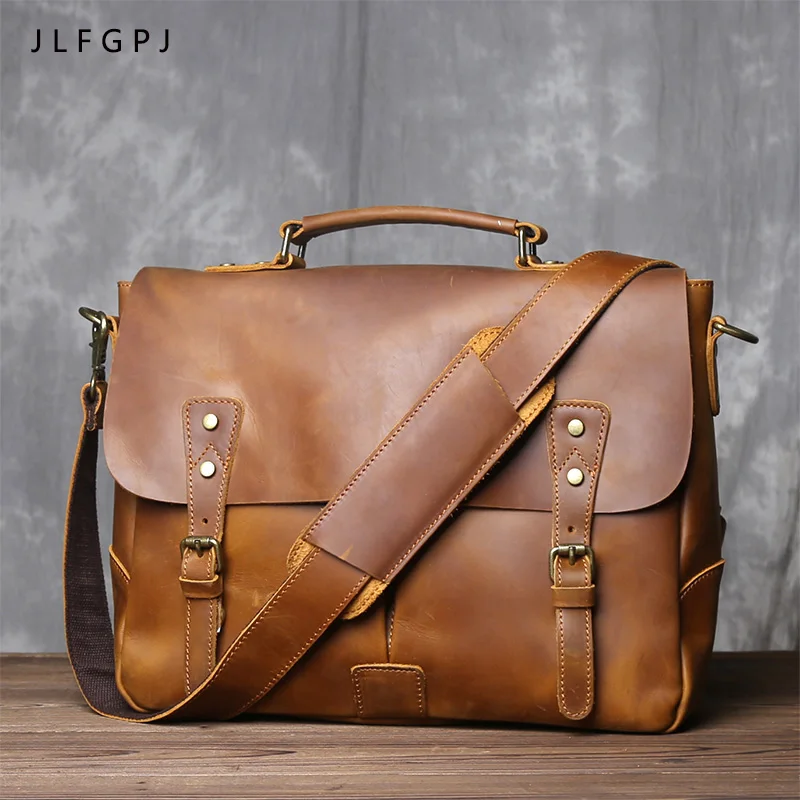
Coordinating Your Leather Messenger Bag with Other Accessories
Leather Coordination: Shoes, Belts, and Watches
Traditional style guidelines suggest matching all leather accessories perfectly. Modern approaches offer more flexibility while maintaining cohesion. The key lies in intentional coordination rather than rigid matching.
For professional environments, follow these leather coordination principles:
- Match leather colors within the same family rather than seeking identical shades
- Ensure leather finishes complement rather than clash (avoid pairing high-gloss shoes with matte distressed leather bags)
- Coordinate hardware metals between your bag, watch, and any visible belt buckle
- Create a visual connection between at least two leather elements (typically shoes and bag)
Mastering coordination between messenger bags and shoes means understanding when exact matching matters more: formal business settings generally require closer color matching, while creative or casual environments allow greater variation.
For black leather, matching is relatively straightforward. With brown leather’s many variations, focus on temperature (warm vs. cool undertones) and depth (light vs. dark) rather than exact color matching. A chocolate brown messenger bag works harmoniously with walnut brogues even though the shades differ.
Hardware coordination creates subtle cohesion—silver-tone watch and belt buckle paired with silver-tone bag hardware presents a thoughtfully assembled appearance. This detail-oriented approach signals attention to refinement that extends to your professional capabilities.
Balancing Your Bag with Other Carry Items
Modern professionals often find themselves needing to carry multiple items—laptop cases, gym bags, lunch totes—alongside their primary messenger bag. Managing these practically while maintaining style presents a common challenge.
Follow these principles for sophisticated multiple-bag management:
- Consolidate when possible—choose a messenger bag sized appropriately to accommodate your most frequent additional items
- Maintain visual balance—if carrying multiple bags, choose complementary rather than competing styles
- Consider scale—a large messenger bag paired with another large tote creates visual heaviness
- Create intentional coordination between multiple bags through color, material, or design elements
- Position bags on opposite sides of your body when feasible to maintain physical and visual balance
In professional settings, consolidation generally presents the most polished appearance. When multiple bags are unavoidable, ensure your primary messenger bag remains the focal point, with secondary bags in supporting roles visually.
For travel situations requiring multiple bags, consider how they stack or nest when set down. Bags that work together functionally present a more intentional appearance than those that compete for space or attention.
Maintaining multiple leather accessories with consistent care routines ensures they age harmoniously, developing complementary patinas that enhance rather than detract from your professional appearance.
Practical Considerations for Daily Use
Maintaining Style While Maximizing Functionality
The most stylish messenger bag fails if it doesn’t fulfill your practical needs. Balancing appearance with functionality ensures your bag enhances rather than hinders your daily experience.
Consider these practical styling approaches:
- Pack strategically—distribute weight evenly to maintain the bag’s intended shape
- Use internal organizational features to prevent bulging or asymmetrical weight
- Place frequently accessed items in easily reachable pockets to minimize rummaging
- Consider the bag’s silhouette when packed—overstuffing compromises both appearance and comfort
- Reserve 10-15% of capacity to maintain proper shape and ease of access
Packing consistency creates muscle memory for retrieving items smoothly, preventing the unprofessional fumbling for essentials during meetings or presentations. This organizational discipline maintains your bag’s external appearance while enhancing its practical functionality.
For items that could potentially leak or damage your bag’s interior, use protective pouches or dedicated compartments. This protection preserves both aesthetic appeal and functionality over time.
Organizing documents in leather bags requires particular attention—flat, rigid items should be positioned against the bag’s back panel where they help maintain structure rather than create awkward bulges. This placement contributes to a sleeker external profile while protecting important papers.
Preserving Your Bag’s Appearance On the Go
Daily use inevitably exposes your messenger bag to potential damage, but proactive maintenance preserves both appearance and function. Simple habits integrated into your routine protect your investment while maintaining professional presentation.
Incorporate these practices into your daily routine:
- Wipe down leather with a dry, soft cloth at day’s end to remove dust and environmental residue
- Address water exposure promptly by blotting (never rubbing) with an absorbent cloth
- Keep leather-specific wipes for addressing minor stains or marks while away from home
- Store small items in internal pockets or pouches to prevent them from scratching or marking the leather
- Establish a “bag landing spot” in offices and home to avoid floor placement that increases wear
When transitioning between significantly different environments (particularly temperature and humidity changes), allow your bag brief adjustment time before handling when possible. This reduces stress on leather that can lead to premature aging or damage.
Storage during work hours also affects appearance—hanging your bag on a dedicated hook rather than placing it on floors prevents unnecessary scuffs and maintains cleaner lines. This thoughtful treatment preserves the bag’s appearance throughout its lifetime.
Understanding how different leather types respond to daily wear allows you to select bags with wearing patterns that align with your style preferences. Full-grain leather develops distinctive character with use, while treated leathers maintain more consistent appearance over time.
Canvas & Leather Messenger Bag, Leather Commuter Tote
$80.41 Select options This product has multiple variants. The options may be chosen on the product pageCrazy Horse Leather Satchel, Men's Leather Satchel, Men's Professional Leather Messenger, Vintage Style Messenger Bag
$132.70 Select options This product has multiple variants. The options may be chosen on the product pageBrown Leather Messenger Bag, Men's Leather Satchel, Men's Professional Leather Messenger
$118.87 Select options This product has multiple variants. The options may be chosen on the product pageBlack Leather Messenger Bag, Black Leather Work Tote, Faux Leather Work Tote
$101.88 Select options This product has multiple variants. The options may be chosen on the product pageCrazy Horse Leather Satchel, Leather Laptop Satchel, Men's Leather Satchel
$304.47 Select options This product has multiple variants. The options may be chosen on the product pageBrown Leather Briefcase, Classic Laptop Briefcase, Crazy Horse Leather Satchel, Men's Classic Leather Briefcase
Price range: $172.15 through $200.02 Select options This product has multiple variants. The options may be chosen on the product page
Care and Maintenance for Lasting Style
Essential Leather Care Routines
Proper leather maintenance ensures your messenger bag remains stylish for years while developing desirable character rather than premature wear. Establishing consistent care routines protects your investment and maintains professional appearance.
Implement this basic leather care schedule:
- Weekly: Wipe down with soft, dry cloth to remove dust and debris
- Monthly: Clean with appropriate leather cleaner for your specific leather type
- Quarterly: Apply leather conditioner to prevent drying and cracking
- Biannually: Deep clean and apply protectant appropriate to your leather finish
Different leather types require specific approaches:
- Full-grain leather benefits from regular conditioning to maintain suppleness
- Top-grain leather typically needs less frequent conditioning but benefits from protection against staining
- Distressed or pull-up leathers often require specialized care to maintain their distinctive appearance
Address common issues promptly:
- Minor scratches on most leathers can be diminished by gently rubbing with a clean finger (natural oils often reduce visibility)
- Water spots should be allowed to dry naturally, then addressed with appropriate leather conditioning
- Ink or difficult stains generally require professional intervention—avoid DIY solutions that may compound damage
Professional leather care becomes necessary when facing significant stains, structural damage, or when your bag needs comprehensive restoration. Quality leather responds remarkably well to professional treatment, often returning to like-new appearance.
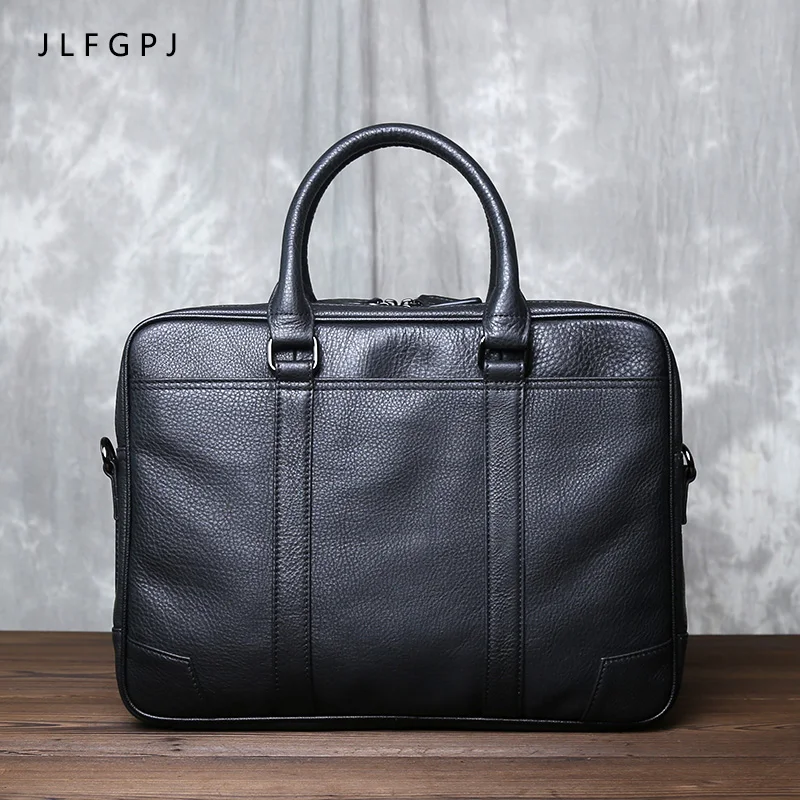
Storage Solutions to Maintain Shape and Appearance
Proper storage when your messenger bag is not in use preserves its shape, prevents damage, and maintains its styling potential. This becomes particularly important for occasional-use bags or during seasonal transitions.
Follow these storage best practices:
- Empty completely before storage—forgotten items can cause stretching or unwanted impressions
- Stuff with acid-free tissue paper or a bag pillow to maintain shape and prevent creasing
- Store in a breathable dust bag or pillowcase—never in plastic, which can trap moisture
- Position on a shelf or hang from straps rather than stacking under heavy items
- Maintain moderate humidity and avoid direct sunlight or heating vents
For long-term storage:
* Apply appropriate leather conditioner before storing
* Check periodically for dust accumulation or shape distortion
* Re-stuff and reposition quarterly to prevent permanent creasing
These practices apply to all quality bags, including vegan leather alternatives, which benefit from proper storage to maintain their appearance and structure.
Travel storage requires particular attention—use your bag’s dust cover or a pillowcase when packing in luggage to prevent friction damage from other items. Always allow bags to return to room temperature and normal humidity before handling after travel to prevent stress on seams and leather.
For those with multiple bags, rotation prevents excessive wear on any single item while allowing rest periods that extend each bag’s lifespan. This rotation strategy allows leather to recover between uses while providing appropriate options for different settings and seasons.
Answering Common Styling Questions
Breaking Traditional Rules: When and How
Style rules provide useful guidelines, but knowing when and how to thoughtfully break them demonstrates true style mastery. With leather messenger bags, several traditional rules deserve reconsideration.
Can I mismatch my leathers?
The traditional rule demands matching leather accessories exactly. The modern approach allows intentional variation within the same color family. Black still generally works best with black, but brown leather offers significant flexibility. The key lies in confidence and consistency—your choices should appear deliberate rather than accidental.
Are messenger bags appropriate for formal business?
While briefcases traditionally dominate formal settings, streamlined messenger bags in premium leather can work beautifully with suits when the design is minimal and the leather quality exceptional. Choose hand-carry over crossbody wearing for the most formal presentation.
What bag size suits my body type?
Traditional advice recommends bag size proportional to height and build. While this provides a useful starting point, personal style and functional needs can justify thoughtful deviation. A smaller individual can carry a larger bag if their style and needs support this choice, though extreme disproportions generally appear unbalanced.
Can messenger bags work in conservative environments?
Professional women’s leather messenger bags and their men’s counterparts can succeed in even traditional settings when chosen with care. Select structured shapes, premium materials, minimal hardware, and conservative colors. The bag’s quality should match the standards of other business accessories.
The most successful rule-breaking follows this principle: understand the rule fully before breaking it, then break it with purpose and consistency. This intentional approach demonstrates style confidence that enhances rather than undermines professional credibility.
Troubleshooting Specific Styling Challenges
Even the most versatile messenger bags present occasional styling challenges. These solutions address common dilemmas while maintaining style integrity.
Challenge: Styling an unusual colored bag
Solution: Treat the bag as an intentional accent piece. Build outfits around neutral foundations (navy, gray, black, white), allowing the distinctive bag to serve as the controlled pop of color. Ensure at least one other minor element (pocket square, socks, watch band) references the bag color to create cohesion.
Challenge: Adapting an oversized messenger bag
Solution: Balance proportions by keeping clothing more fitted and structured. Avoid voluminous outerwear when carrying larger bags. When possible, use compression straps to maintain a sleeker profile. Position higher on the body than you would a standard-sized bag.
Challenge: Making a well-worn bag work in professional settings
Solution: Embrace patina as character while ensuring cleanliness and structural integrity. Pair vintage or distressed bags with crisp, pristine clothing to create intentional contrast. Consider hand-carrying rather than crossbody wearing for more formal occasions.
Challenge: Transitioning between conservative and creative environments
Solution: Invest in a bag with transitional versatility—clean lines and quality materials but with subtle distinctive details. Comparing leather and canvas messenger options reveals that leather-predominant styles with minimal canvas accents can bridge these environments effectively.
Challenge: Coordinating unusual hardware colors
Solution: When bag hardware doesn’t match your typical accessories, create intentional separation by avoiding close proximity. For example, position a bag with brass hardware away from a belt with silver buckle rather than trying to force coordination.
The most effective solutions maintain your personal style while acknowledging context-appropriate adjustments. This balance between personal expression and situational awareness characterizes sophisticated style sensibility.
Conclusion: Your Messenger Bag as a Style Signature
Your leather messenger bag represents far more than a practical carrying solution—it’s a daily companion that communicates your attention to detail, appreciation for quality, and personal style philosophy. The most successful styling approaches recognize this dual nature, treating the bag as both functional tool and aesthetic statement.
The styling principles we’ve explored demonstrate the remarkable versatility of quality leather messenger bags. From casual weekend outfits to boardroom presentations, the right bag appropriately styled enhances your presence while serving your practical needs. This versatility makes a quality leather messenger bag among the most valuable accessories you can invest in.
As you apply these styling techniques, remember that confidence remains the most important element. When you select a messenger bag that genuinely reflects your personal style and functional requirements, wearing it becomes an authentic expression rather than a forced fashion statement. This authenticity resonates more powerfully than rigid adherence to any style rule.
Your messenger bag will likely accompany you through countless professional challenges and personal victories. The patina it develops—unique to your journey—transforms it from a mere accessory into a personal artifact. Embrace this evolution while maintaining its functional integrity through proper care and thoughtful styling.
Take these principles as foundations to build upon rather than rigid limitations. The most compelling personal style comes from understanding guidelines and then thoughtfully adapting them to express your unique perspective and meet your specific needs.

